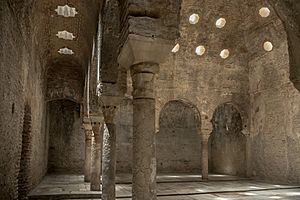El Bañuelo facts for kids
The Bañuelo is an old hammam (an Islamic bathhouse) in Granada, Spain. Its name means "little bath" in Spanish. It's also known as the "Bath of the Walnut." This historic building is found in the Albaicin area, right by the Darro River. People used it as a bathhouse until at least the 1500s. After that, it stopped being a bathhouse and was used for other things. In the 1900s, experts in Spain fixed it up. Today, you can visit it as a cool tourist spot.
Contents
Discovering the Bañuelo's History
What were Hammams?
Bathhouses, or hammams, were very common in Muslim cities long ago. They were important for both social life and religious practices. Muslims used them for washing, especially for a full-body wash called ghusl. This wash was needed for certain religious duties. Hammams also helped people stay clean and were places where friends could meet and chat. Their design and how they worked were based on the Roman bathhouses. Roman baths had been part of city life in this area for many years before the hammams.
The Bañuelo's Past
About twelve old Islamic bathhouses have been found in Granada. Most of them are quite simple. However, the 14th-century Comares Baths in the Alhambra are very fancy. The Bañuelo is the only hammam in Granada, outside the Alhambra, that has been restored for people to visit.
Experts believe the Bañuelo was built in the 11th century. This was during the time of the Zirids, a kingdom based in Granada. Some think it was built when Badis or Abdallah was king. Other researchers think it might be from the 12th century or even later. This is based on how it's designed and the way its walls are built. These baths were likely inside the al-Qasaba al-Qadima, an old royal fortress. This area later became the Albaicin, before the Alhambra became the main palace.
From Baths to Tourist Site
In 1492, Granada was taken over by Spanish Catholics. Even after this, the bathhouse was still used and fixed up during the 1500s. This was because many morisco people (Muslims who stayed in Spain) still lived in the city. Later on, the baths stopped being used for bathing. They became a public laundry place. Then, part of the building was used as a home.
In 1918, the Bañuelo was named a Cultural Heritage Property of Spain. This means it's a very important historic site. The first restoration work began in 1927-28. More work continued throughout the 1900s. Today, the building is open for everyone to explore as a historic site.
Exploring the Bañuelo's Design
How the Rooms Were Used
The baths had several main rooms, one after another. When you first walked in from the street, you entered a reception or relaxation room. This room had a square water pool in the middle. Today, this room is open to the sky, but it used to have a large wooden dome ceiling. In one corner, a door led to three small toilet rooms. Another door led to the changing room, like the apodyterium in Roman baths.
From the changing room, visitors went into the steam rooms. There were three of these:
- The cold room (bayt al-bārid), similar to a Roman frigidarium.
- The warm room (bayt al-wasṭānī), like a Roman tepidarium.
- The hot room (bayt al-sakhūn), like a Roman caldarium.
Bathers would start in the cold room. Then, they would move to the warm room, and finally to the hot room. The hot room's purpose was to make people sweat a lot. This was part of the cleaning process. Bathhouse workers would also clean visitors by rubbing and massaging them. Unlike some other steam baths, people in Muslim hammams didn't actually get into a pool of water. Instead, they washed themselves at the end by having warm water poured over them.
Inside the Warm Room
In the Bañuelo, the biggest room is the warm room (bayt al-wasṭānī). This was a common design for many bathhouses in al-Andalus (Islamic Spain). It has a large central vault or dome ceiling. Smaller barrel vault sections surround this dome on three sides. All these ceilings rest on marble columns with horseshoe arches between them. Many of the tops of these columns (called capitals) were reused from older buildings. Some were from the Roman period, and others from the Caliphate period.
The ceilings have small star-shaped and octagonal skylights. These let in light and allowed extra steam to escape. Both the cold room before it and the hot room after it were rectangular. They also had barrel vaults with skylights. Each end of these rooms had a column between two horseshoe arches.
How the Baths Stayed Warm
Beyond the hot room was the service area. This part was lower than the other rooms. It held the furnace and boiler. This furnace heated the water for the steam rooms. It also made hot air and smoke. This hot air traveled through pipes under the floors of the hot and warm rooms. This system was similar to the Roman hypocaust system. The hot air then went up through the walls and out through the chimneys.
-
A Caliphate-era capital, one of several older capitals reused in this part of the baths
See also
 In Spanish: El Bañuelo para niños
In Spanish: El Bañuelo para niños
- Caliphal Baths
- Arab Baths of Jaén
- Hammam Saffarin








